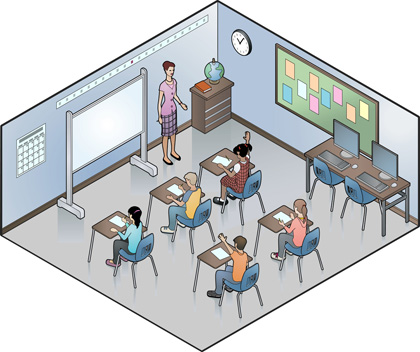Tuesday, November 24th, 2009
[I recently learned an article I wrote late this past summer was picked up in a publication called The State of the School Market Report. Thought I’d share with my blog followers until the time when I post more interviews as promised. Stay tuned!]

Over the summer a relative who had just completed her first year of teaching came by for a visit. She was excited to share all the news about her classroom experience. My spouse and I are both teachers so we were excited to hear her news. She’s a smart, energetic and tech savvy person who, during her last visit, shared that she had found a great teaching position in the DC area. What she didn’t know until she started was that she would be the first teacher in her school to receive an interactive whiteboard. Not only was she thrilled to use this new technology, she said her students couldn’t get enough of it.
“What was it about the whiteboard that made your kids so excited?” I asked. She responded “The kids love to get up and interact with the board. It’s really empowering. Even students that show little interest during classroom time wanted to participate.”
“Not only that, ” she continued, “I also received ‘clickers’ with my whiteboard, so I can conduct in-class polls and interactive quizzes in real time. Using the clickers with an interactive whiteboard (IWB) allows me to know who is participating and who is not. Who gets it and who doesn’t. I’m so lucky to have both pieces of technology available to me. Other teachers in the school often poke their head in to see what all the fuss is about. It’s really cool!”
Immediately I thought of that old Chinese proverb:
“Tell me and I’ll forget;
show me and I may remember;
involve me and I’ll understand.”
Could it be that interactive whiteboards have the potential to re-invent and re-invigorate education in a way never experienced before? You bet, but that journey has just begun and there’s a long road ahead.
While following a recent House of Representatives discussion on the Future of Education, I learned more about the successes of interactive whiteboards in the classroom but was surprised to find out that only 16% of classrooms in the US were using interactive whiteboards whereas 70% of UK classrooms were using the same technology. Why was the US so far behind in implementing IWBs into classrooms? This number will most definitely rise in the US, in part due to the ARRA stimulus package that recommends schools invest in interactive whiteboard technology, but still there are more issues at stake here than just universal classroom access.
This past spring, I was surprised to find many education publishers scrambling to figure out what their interactive whiteboard product response would be. They all wanted to be a player in this fast moving ed tech arena, but it felt that not enough serious thought was going into how best to use this new medium. I could hear the publishers thinking out loud; What new products should they consider making? How should they be developed? What states should they target? What relationships need to be formed? It’s clear that there’s huge opportunity here in the IWB product space, and proof could be found in many places. Testimonials from satisfied teachers, IWB visibility at this year’s NECC event, ed newspaper and magazine articles, the projected 700, 000 IWB units to be sold in 2009. However, not all IWB solutions are destined for immediate classroom success.
In the same way that there are differences between what makes a textbook successful and what makes for a great online learning experience, publishers need to pay close attention to what makes an interactive whiteboard applications succeed. Simply converting static text pages into static PDFs is not the answer. That may work for overhead projectors, but doing so turns an interactive whiteboard into a very expensive overhead projector, a huge waste of technology dollars. Instructional specialists need to exploit the opportunities presented by interactivity and student participation. Instruction changes dramatically when you make the shift from linear print or “sage on the stage” lectures to interactive engagement. The IWB products that will succeed are ones that understand this small, but very important difference. It’s a vital component that traditional editorial experts might miss.
Media expert Marshall McLuhen, father of the phrase “The medium is the message, ” quoted years ago that when communication changes as a result of new media technologies. “It is the framework which changes… not just the picture within the frame.” Publishers might easily focus to closely on the content that appears within the frame at the expense of the entire framework. Having an intimate understanding of the framework is what will lead to “frame” successes with interactive whiteboards. Until this concept becomes universally understood by creators and publishers of IWB materials, schools might easily end up purchasing products that will do little to benefit and involve students effectively. The same can be said with any new technology, not just interactive whiteboards.
So, if interactive whiteboards become commonplace in all classrooms and IWB products include meaningful interactions that students can benefit from, our education future looks bright and rosy, yes? Well, almost.
The last piece of the puzzle that will push interactive whiteboard success over the top involves teachers. The language and method of teaching in an interactive manner may prove a challenge at first for some teachers. Not because new technologies introduce technical hurdles that are too big to get over, though that can happen. The delivery of instructional content that is interactive is different. The teaching process can change when you invite student participation and interaction though IWBs. Interactive instruction can include many more two-way conversations, involving students at a deeper level of understanding than through traditional methods. This is a great opportunity, and one that needs to be supported with professional development. Those comfortable with the language of interactivity may thrive whereas teachers who are less familiar making a connection through such interactions with technology will need guidance.
I’m excited by the opportunities that lie ahead for schools that embrace interactive whiteboards. Our young relative is too. She’s eager to return to the classroom, having just accepted a new teaching position at Virginia school that has an interactive whiteboard in every classroom. “That’s fantastic!” we exclaimed! “Yes, it is, ” was her somewhat somber reply “but friends of mine who are just now accepting teaching positions in other areas the country are not so lucky. Many of them are going into schools that have yet to invest in interactive whiteboards. I can’t imagine doing that after the success I had in my own classroom.” I said not to worry. “They will have their chance. This is a change that is moving quickly. If they don’t have whiteboards available this year, I’m betting they will soon, and I’m sure the IWB hardware and software solutions are certain to be even better next year.”


